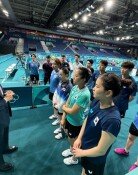S. Korea’s demographic cliff
S. Korea’s demographic cliff
Posted January. 04, 2021 07:32,
Updated January. 04, 2021 07:32
South Korea’s registered residents stood at 51,829,000 last year, down 28,000 from the previous year, the Public Administration and Security said Sunday. It is the first time ever that the number of registered residents has declined. It is shocking news even considering South Korea’s combined fertility rate, which has fallen to 0.8 per woman, a lowest level in the world, and the rapidly aging population.
The number of newborns in South Korea declined to 276,000 last year, as it fell below the 300,000 level, while the number of deaths increased, making a reality the ‘dead cross’ phenomenon in which the overall population naturally declines. One in four South Koreans have become the aged group of 60 or older, while the number of single-member households surpassed 9 million for the first time as the number of youth and senior citizens living alone jumped 6.8 percent.
When considering examples of advanced countries in the West and Japan, a falling fertility rate and the aging population will inevitably lead to shortages of labor, a decline in consumption, contraction in industrial production, and a deteriorating national finance. The Seoul government announced a ‘basic plan on low birthrate and aging population’ last month, as it easily predicted such a grave situation. Critics say, however, measures such as payment of childrearing subsidies including 300,000 won (275 US dollars) per month to parents who have a newborn, and up to 6 million won (5,510 dollars) to the parents who concurrently use maternity and fraternity leave for three months together, will hardly be sufficient to resolve ‘demographic cliff’ that is becoming a pressing crisis. The past administrations have learned the lesson and reached the conclusion after spending 180 trillion won (about 165 billion dollars) over the past 15 years that increasing temporary subsidies will not solve the problem. Worse still, the incumbent administration has put off the implementation of the new measure to 2022, when South Korea will have the next presidential election,’ earning the criticism that ‘Is the government timing the execution of a measure to shore up the plunging fertility rate, a pressing issue, with a political event?’
With perceived youth unemployment reaching as high as 24.4 percent, which means one in four effectively unemployed, it would be difficult to expect more marriages and higher fertility rate among the youth group. The government’s ill-advised real estate policy, which has continued for more than three years, and its claim that “housing supply is sufficient” without properly considering a soaring number of single-member households, has caused major hikes in housing and rent prices, worsening the housing environment for youth.
After all, a fundamental solution to the low fertility rate is creation of quality jobs and provision of good housing. Korea will not be able to escape from the trap of a low birthrate and the aging population unless it empowers companies that are responsible for job creation, and switches its housing policy to one of housing supply centered on the private sector.







